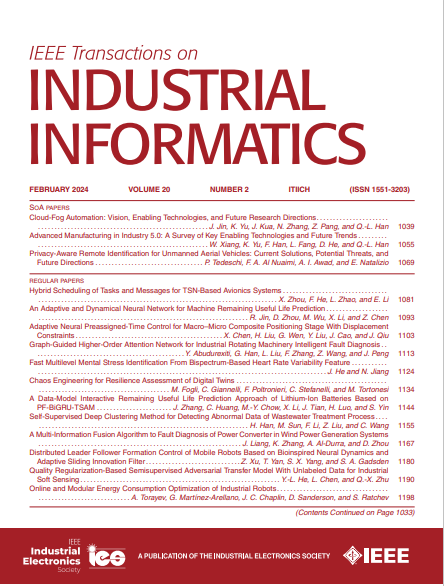基于时空注意对抗性自编码器的高压磨辊异常检测
IF 9.9
1区 计算机科学
Q1 AUTOMATION & CONTROL SYSTEMS
引用次数: 0
摘要
在高压磨辊(HPGR)中,持续的产品质量和高效的运行在很大程度上依赖于实时异常检测。复杂性来自原材料的波动、进料过程和不可预见的中断,以及传感器数据固有的时空动态。本文通过提出一种利用云、边缘设备和强大算法(基于时空注意力(STA)的最小门控单元(MGU)对抗性自动编码器(AAE))的协作异常监控架构来解决这些挑战。该算法在云端进行训练,分析传感器数据,包括HPGR内的信息、材料和能量流。它的核心优势在于通过一种新颖的时空注意机制来捕捉时空数据模式之间复杂的相互作用。此外,对抗性训练增强了模型区分正常操作和异常操作的能力。边缘设备执行实时监控,并将预处理数据传输到云端进行STA-MGU-AAE分析。提取的特征不仅可以准确地检测过程变量中的异常,还可以促进根本原因分析,从而显著提高过程的稳定性和可靠性。通过实际选矿实验验证了所提出的体系结构的有效性,证明了其在生产过程中彻底改变高压高压gr异常监测的潜力。本文章由计算机程序翻译,如有差异,请以英文原文为准。
Spatio-Temporal Attention Adversarial Autoencoders for Enhanced Anomaly Detection in High-Pressure Grinding Rolls
Consistent product quality and efficient operations in high-pressure grinding roll (HPGR) rely heavily on real-time anomaly detection. Complexities arise from fluctuations in raw materials, feeding processes, and unforeseen disruptions, along with the inherent spatio-temporal dynamics of sensor data. This article addresses these challenges by proposing a collaborative anomaly monitoring architecture that leverages the cloud, edge devices, and a powerful algorithm: The spatio-temporal attention-based (STA) minimal gated unit (MGU) adversarial autoencoder (AAE). The proposed algorithm, trained in the cloud, analyzes sensor data encompassing information, material, and energy flows within the HPGR. Its core strength lies in capturing the intricate interplay between spatial and temporal data patterns through a novel spatio-temporal attention mechanism. In addition, adversarial training enhances the model's ability to distinguish normal operations from anomalies. Edge devices perform real-time monitoring and transmit preprocessed data to the cloud for STA–MGU–AAE analysis. The extracted features not only enable accurate anomaly detection in process variables, but also facilitate root cause analysis, leading to significant improvements in process stability and reliability. The effectiveness of the proposed architecture is validated through practical beneficiation experiments, demonstrating its potential to revolutionize HPGR anomaly monitoring in production processes.
求助全文
通过发布文献求助,成功后即可免费获取论文全文。
去求助
来源期刊

IEEE Transactions on Industrial Informatics
工程技术-工程:工业
CiteScore
24.10
自引率
8.90%
发文量
1202
审稿时长
5.1 months
期刊介绍:
The IEEE Transactions on Industrial Informatics is a multidisciplinary journal dedicated to publishing technical papers that connect theory with practical applications of informatics in industrial settings. It focuses on the utilization of information in intelligent, distributed, and agile industrial automation and control systems. The scope includes topics such as knowledge-based and AI-enhanced automation, intelligent computer control systems, flexible and collaborative manufacturing, industrial informatics in software-defined vehicles and robotics, computer vision, industrial cyber-physical and industrial IoT systems, real-time and networked embedded systems, security in industrial processes, industrial communications, systems interoperability, and human-machine interaction.
 求助内容:
求助内容: 应助结果提醒方式:
应助结果提醒方式:


